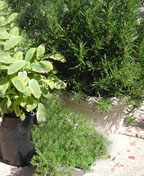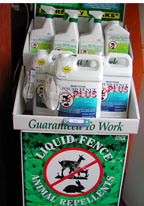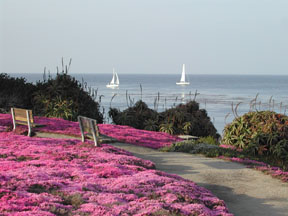Bay CrossingsGardens
 Gardening with Deer in Mind
Gardening with Deer in Mind
By Botany Bob
Customers shopping in a nursery spot a
plant that they like. They ask a litany of questions all to
which the nurseryman can respond with a positive resounding
yes and the sale is virtually made. Then comes the Kibosh,
“Do the deer eat it?” End of the sale. It is sad and
frustrating for nurserymen and customers. Frustration can be
a driving force to learn.
Landscaping for deer resistance offers
gardeners an opportunity to learn about fascinating new
plants that come from some of the most remote and exotic
places: the Australian Outback, the Greek Isles, the South
African Veldt, for example. Take a trip to the UC Botanic
Gardens of Santa Cruz. For the plant lover, it is as
exciting as outer space is to the astronaut. There are also
many good magazine articles, books, and pamphlets that rate
plant material for deer resistance. When preparing to plant
in an open area or front yard garden in any bayside or
coastal area deer are of common concern and consideration in
choosing what to plant and how to protect new plantings.
 Imagine being a child, walking with a
teacher in a class through an herb garden. With the special
focus children give to learning, the teacher invites the
children to smell, look closely, and touch the sage,
rosemary, and various scents of thyme. Next, the teacher
asks the children to inspect the arrangement of the leaves,
noting they are always opposite and feature square stems,
with flowers appearing to be structurally alike. Children in
the class would also learn that these divine scents, all of
the mint family as wonderful and as useful as they are,
actually improve the plant’s chances
Imagine being a child, walking with a
teacher in a class through an herb garden. With the special
focus children give to learning, the teacher invites the
children to smell, look closely, and touch the sage,
rosemary, and various scents of thyme. Next, the teacher
asks the children to inspect the arrangement of the leaves,
noting they are always opposite and feature square stems,
with flowers appearing to be structurally alike. Children in
the class would also learn that these divine scents, all of
the mint family as wonderful and as useful as they are,
actually improve the plant’s chances
 for survival. Many
animals that browse, like deer, find the chemical scents
intolerable, if not poisonous. Althought alike in some ways,
the body chemistries between mammals can be decidedly
different.
for survival. Many
animals that browse, like deer, find the chemical scents
intolerable, if not poisonous. Althought alike in some ways,
the body chemistries between mammals can be decidedly
different.
 In June, the Mint family (lamiaceae) literally bursts with
every color of the rainbow, especially the New World
Salvias, Old World Phlomis and Leonitis, as well as sage,
rosemary, thyme, and lavender, all virtually deer proof. It
is still advisable to spray anything newly planted with a
deer repellent such as Liquid Fence once a week for three
weeks to prevent deer from pulling recent plantings out of
the ground. It may be that a plant newly moved from one
environment to another emits a chemical signal that
indicates soft growth or perhaps weakness that makes them
particularly vulnerable and often targeted. Once a new plant
is settled into its new home with proper light, amended
soil, and moisture, it should be ready to take on the deer.
In June, the Mint family (lamiaceae) literally bursts with
every color of the rainbow, especially the New World
Salvias, Old World Phlomis and Leonitis, as well as sage,
rosemary, thyme, and lavender, all virtually deer proof. It
is still advisable to spray anything newly planted with a
deer repellent such as Liquid Fence once a week for three
weeks to prevent deer from pulling recent plantings out of
the ground. It may be that a plant newly moved from one
environment to another emits a chemical signal that
indicates soft growth or perhaps weakness that makes them
particularly vulnerable and often targeted. Once a new plant
is settled into its new home with proper light, amended
soil, and moisture, it should be ready to take on the deer.
South African plants and Australian plants
provide the gardener with an unlimited palette for
deer-resistant plantings. Three prominent families
immediately come to mind: the composites (daisies), myrtles
and proteas. Among the first are Osteospermums, Arctotis,
Delosperma (ice plants), Dimorphotheca, all from South
Africa. Occasionally there are complaints about the deer
nibbling these plants, but as habitat destruction continues,
coupled with months without rain, even established plants
are subject to some browsing if not protected. When these
plants are grown in mass display or sprayed once a month
with a deer repellent, there is little problem. All these
varieties of daisies require full sun, ample moisture, some
humus, and occasional fertilizer to succeed. Most problems
occur when they are planted in the shade. One plant group of
daisies, the Helichrysum, derived from the Greek roots
helios, sun, and chryson, golden, never seem to fail. The
plant group contains the straw flower which now comes in
designer colors. Try massing golden Helichrysum heindrichii
with lavender ‘Hidcote’ for a breathtaking display. This
Helichrysum looks like the ubiquitous yarrow, but deer won’t
touch it and it seems to always be in bloom.
 Members of the Protea and Myrtle families
from, you guessed it, South Africa and Australia are also
highly deer resistant. They often reach their bloom climax
in winter, when most plants are tuckered out. With the
proper terrain of excellent drainage and sun, these plants
thrive with the least care, which may be another garden
tale.
Members of the Protea and Myrtle families
from, you guessed it, South Africa and Australia are also
highly deer resistant. They often reach their bloom climax
in winter, when most plants are tuckered out. With the
proper terrain of excellent drainage and sun, these plants
thrive with the least care, which may be another garden
tale.
Another defense strategy plants employ to
avoid being eaten is to grow where nothing else can. As blue
and purple spires of Pride of Madeira disappear all too soon
in April, they are replaced in May by the common cottage
garden Valerian, growing in the crevices of rocks and in
nutrient poor soils on impassable cliff faces. Approaching
from the north and heading toward the Golden Gate Bridge on
Hwy 1, one cannot but be moved by this triumphant plant in
every shade of red, pink, and brilliant white. In the City,
this same plant, also known as Centranthus ruber, not to be
confused with the herb Valerian, emerges from the crevices
of sidewalks and where a smidgen of soil has gathered
between the concrete foundations of buildings and the edge
of driveways.
 As urban sprawl and the loss of habitat
continue to bode ill for the deer, it is hoped that research
and sound wildlife management will find a way to manage
healthy herd size and preserve this noble animal. With
survival and cohabitation of the region in mind, perhaps
gardeners with the good fortune to have a large lot of land
could provide some browsing plants and water amidst a garden
that contains well-chosen deer resistant natives and
non-invasive exotics. As shown in the photo, it is an option
to have a garden that includes only natives, with plant
varieties that actually improve with browsing. (For more
information on this subject, send a letter to Botany Bob
care of Bay Crossings, or stop by Bayside Gardens on Tiburon
Blvd, just three blocks from the ferry landing in Belvedere
and talk to the plant doctor.)
As urban sprawl and the loss of habitat
continue to bode ill for the deer, it is hoped that research
and sound wildlife management will find a way to manage
healthy herd size and preserve this noble animal. With
survival and cohabitation of the region in mind, perhaps
gardeners with the good fortune to have a large lot of land
could provide some browsing plants and water amidst a garden
that contains well-chosen deer resistant natives and
non-invasive exotics. As shown in the photo, it is an option
to have a garden that includes only natives, with plant
varieties that actually improve with browsing. (For more
information on this subject, send a letter to Botany Bob
care of Bay Crossings, or stop by Bayside Gardens on Tiburon
Blvd, just three blocks from the ferry landing in Belvedere
and talk to the plant doctor.)